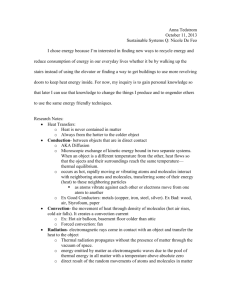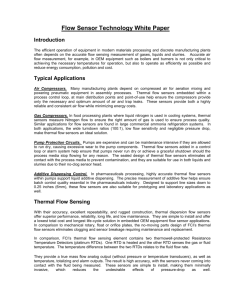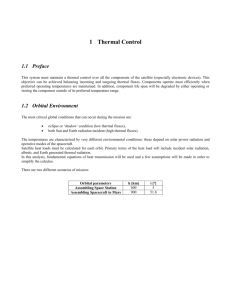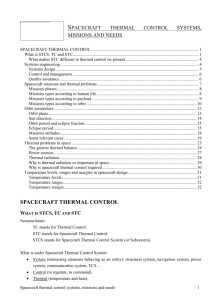COMPASS-2 - TCS - Thermal Description
advertisement
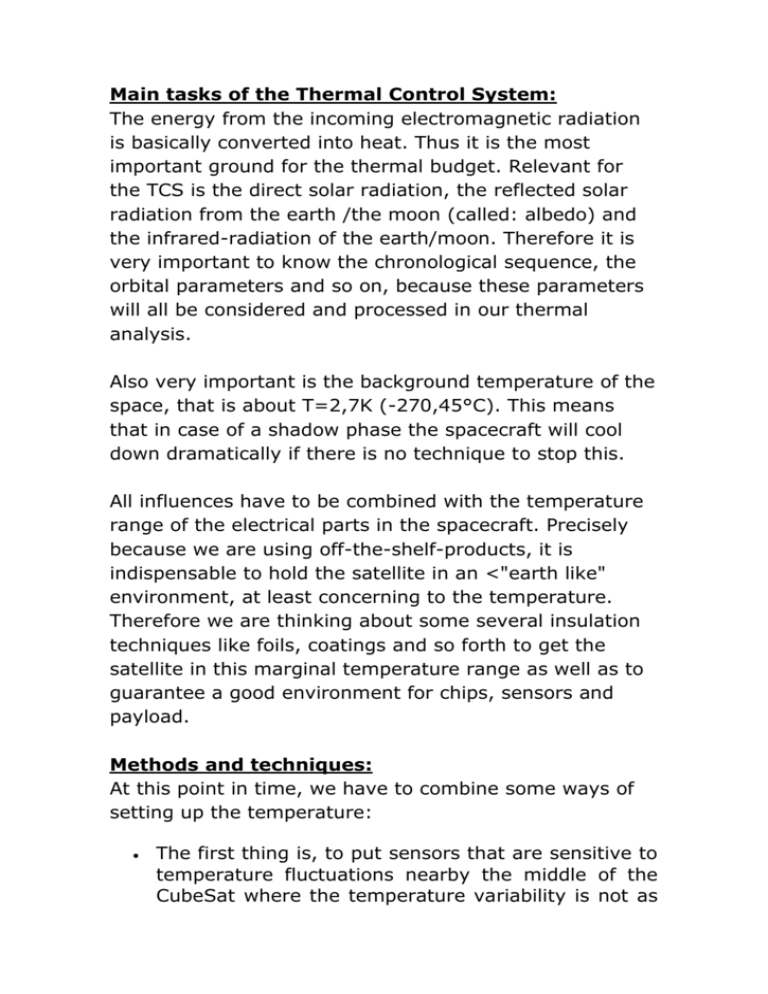
Main tasks of the Thermal Control System: The energy from the incoming electromagnetic radiation is basically converted into heat. Thus it is the most important ground for the thermal budget. Relevant for the TCS is the direct solar radiation, the reflected solar radiation from the earth /the moon (called: albedo) and the infrared-radiation of the earth/moon. Therefore it is very important to know the chronological sequence, the orbital parameters and so on, because these parameters will all be considered and processed in our thermal analysis. Also very important is the background temperature of the space, that is about T=2,7K (-270,45°C). This means that in case of a shadow phase the spacecraft will cool down dramatically if there is no technique to stop this. All influences have to be combined with the temperature range of the electrical parts in the spacecraft. Precisely because we are using off-the-shelf-products, it is indispensable to hold the satellite in an <"earth like" environment, at least concerning to the temperature. Therefore we are thinking about some several insulation techniques like foils, coatings and so forth to get the satellite in this marginal temperature range as well as to guarantee a good environment for chips, sensors and payload. Methods and techniques: At this point in time, we have to combine some ways of setting up the temperature: The first thing is, to put sensors that are sensitive to temperature fluctuations nearby the middle of the CubeSat where the temperature variability is not as high as in the outer regions. This is a very simple way of getting each part in its desired temperature range but mathematically, it is very difficult to calculate. The problem is to get an overview of all parts in use and the information of their electrical energy consumption and in addition the nearby parts and their energy consumption, and above all the area of the part for radiation and conduction to the board. A close collaboration with the CDHS is very essentially. The second way is to study the influence of coatings for the thermal control system. For instance,if the spacecraft is painted in white, it will reflect a lot of the radiation and moreover, it is not able to collect the energy from the sun. This implies that it is getting colder in the satellite, perhaps even too cold. Alternatively, a black painted structure might overheat the satellite. In this case, it is very important to trial and error. The structure of the spacecraft is very small-sized with a small surface that is mostly covered by the solar cells. The effectiveness of this method has to be tested. Figure 1: MLI (Source: Wikipedia) The third thing is to use multi layer insulation (MLI). These are foils composed of multiple layers of thin sheets. It is mainly intended to reduce heat loss by thermal radiation. With MLI we have the ability to control the thermal flux. By increasing or decreasing the number of layers as well as the thickness of the separating foil, on the one hand we can choose whether to let more or less energy to the middle cube. On the other hand MLI also isolates the cube from the space which means that the cube could overheat due to the dissipation from the inner parts. Active heat pipes are able to solve this problem but raise another: a lot more energy consumption and a lot more weight. Here we are. There are a lot of techniques and a lot of problems to solve. This is the reason why TCS is very complicated and computationally intensive (Thermal analysis with finite element method) Another problem is that the TCS has to react quickly to new situations. It is nearly impossible to create a perfect thermal environment in the inside of the spacecraft at the beginning of the construction. Therefore the TCS has to collect all the data of the other subsystems and when the configuration is determined, it will react quickly to clinch this information. Thermal Analysis of Printed Circuit Boards (PCB) and the CubeSat structure: Figure 2: Thermal analyse of C-1Power dissipation is an important issue in present-day PCB design. Power dissipation will result in temperature difference and pose a thermal problem to a chip. In addition to the issue of reliability, excess heat will also negatively affect electrical performance and safety. The working temperature of an IC should therefore be kept below the maximum allowable limit of the worst case. In general, the temperatures of junction and ambient are 125 °C and 55 °C, respectively. The vacuum of the space environment makes heat transfer via air (convection) impossible. The ever-shrinking chip size causes the heat to concentrate within a small area and leads to high power density. Furthermore, denser transistors gathering in a monolithic chip and higher operating frequency cause a worsening of the power dissipation. Removing the heat effectively becomes the critical issue to be resolved. The only way of tranfering the heat to disable overheating and damage is to radiate and to conduct. Therefore we need to increase the area of chip. To calculate the needed area and the interaction between the chip, the nearby chips, the board and other components which can act as storage, cooler or heater is the main task of thermal analysis. (source: modified: Wikipedia) Some information about the hardware: To collect temperature data we have to use temperature sensors. There are a lot of temperature sensors and a lot of pros and cons. We decided in favor of Single-Wire, Digital-Output Temperature Sensors. With these temperature sensors we decrease wire, energy, weight and complexity. At this time, in accordance with the CDHS, the TCS won't get his own board. Instead we will have all our components - excepting the sensors - on the main board.



